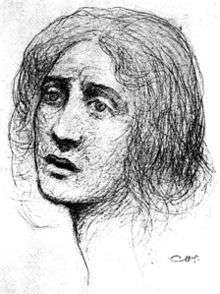Al-Khansa
Tumāḍir bint ʿAmr ibn al-Ḥārith ibn al-Sharīd al-Sulamīyah (Arabic: تماضر بنت عمرو بن الحارث بن الشريد السُلمية), usually simply referred to as al-Khansāʾ (Arabic: الخنساء, meaning "snub-nosed", an Arabic epithet for a gazelle) was a 7th-century tribeswoman of the Arabian Peninsula. She was one of the most influential poets of the pre-Islamic and early Islamic periods[1].
Al-Khansa | |
|---|---|
الخنساء | |
 Al-Khansa's name in Arabic calligraphy | |
| Born | c. 575 Najd, Arabia |
| Died | c. 646 (aged 70–71) Najd, Arabia |
| Occupation | Poetess |
In her time, the role of a female poet was to write elegies for the dead and perform them for the tribe in public oral competitions. Al-Khansāʾ won respect and fame in these competitions with her elegies, and is widely considered as the finest author of Arabic elegies and one of the greatest and best known female Arab poets.[2][3] Some say al-Khansāʾ was Muhammad's favorite poet. He wept when he heard her elegies for her two brothers, Ṣakhr and Muʿāwiyah.[4] She came to Medina in 629 with a deputation from her clan and met the Islamic Prophet Muhammad and fervently embraced the new religion. Her poetry was recorded by Muslim scholars who needed to study undegenerated Arabic in order to explicate Islamic texts[1].
Life

Al-Khansāʾ was born and raised in Najd, Arabia, into a wealthy family, being the daughter of the head of the al-Sharid clan.[3]
al-Khansā’, of the tribe of Sulaym, was undoubtedly the most powerful elegiac poetess of her time. In the pre-Islamic society, the role of a female poet, such as al-Khansā’ was to compose elegies for the tribesmen who fell in the battlefield. Her extraordinary fame rests in mainly on her elegiac poetry composed for her two brothers, Sakhr and Mu‘āwiya, whowere killed in tribal skirmishes of Banū Sulaym with Banū Murra and Banū Asad predating Islam[1].
In 612, her brother Muʿawiyah was killed by members of another tribe. Al-Khansāʾ insisted that her brother, Ṣakhr, avenge Muʿawiyah's death, which he did. Ṣakhr was wounded in the process and died of his wounds a year later. Al-Khansāʾ mourned her two brothers' deaths in poetry, writing over a hundred elegies about the two of them alone,[3] and began to gain fame for her elegiac compositions especially due to her powerful recitals.[3] The contemporary Arab poet al-Nābighah al-Dhubyānī said to her: "You are the finest poet of the jinn and the humans." (Arabic: إنك أشعر الجن والإنس).[5] Similarly, another anecdote says that al-Nabigha told al-Khansāʾ, "If Abu Basir[6] had not already recited to me, I would have said that you are the greatest poet of the Arabs. Go, for you are the greatest poet among those with breasts".[7] She responded by saying, "I'm the greatest poet among those with testicles, too".[8]
She was a contemporary of Muhammad, and eventually converted to Islam.[3] It is said that the prophet Muhammad would ask her to recite some of her poetry for him, and he would love listening to her. Whenever she paused after a recital, he would gesture her to keep going and say, "Rock on, Khunās!"[9][10][11][12] The prophet Muhammad rated al-Khansāʾ over the great Imru' al-Qais, the most famous poet of the classical Arabic tradition, as the one with greater poetic abilities.[13]
She was married at least twice, and had six children, all of whom were also poets and eventually converted to Islam.[3] Four of them, Yazīd, Muʿāwiyah, ʿAmr, and ʿAmrah, were killed in the Battle of Qadisiyah. When she received the news, she allegedly said, "Praise be to God who honored me with their martyrdom. And I have hope from my Lord that he will reunite me with them in the abode of his mercy." (Arabic: الحمد لله الذي شرفني بقتلهم، وأرجو من ربي أن يجمعني بهم في مستقر رحمته).[14]
Poetry
The significance of al-Khansā’, apart from her undeniable poetical talent, was originated from her instrumentality in raising elegiac tradition to the level of qarīd poetry instead of sadj‘ or radjaz. Her methodology, which assured her a superiority in this genre, became stereotyped in the rithā’ poetry after her. The secure position of al-Khansā’, as a female figure within the Arabic literature is extremely unique[1].
See also
- List of famous Arabs
- Women in Arab societies
- Women in Muslim societies
References
- Ayyıldız, Esat (2020). "El-Hansâ' Bint 'Amr: Eski Arap Şiirinde Öncü Bir Mersiye Şairi Hanım". Mütefekkir. 7/13: 201–224.
- Classical Arabic Literature: A Library of Arabic Literature Anthology. Translated by Geert Jan van Gelder. New York: New York University Press. 2013.
- Ghada Hashem Talhami (2013). Historical Dictionary of Women in the Middle East and North Africa. Scarecrow Press. p. 202.
- Yusuf, Hamza. "The Life of the Best of Creation ﷺ". Deen Stream. Retrieved 14 July 2020.
- Ibn Qutaybah (1987). al-Shiʿr wa-al-shuʿarāʾ (in Arabic). Beirut: Dār ʾAḥyāʾ al-ʿUlūm. p. 218.
- "Asha". The Great Soviet Encyclopedia. 1979.
- Butrus al-Bustānī (1968). Udabā' al-Arab fi al-Jāhiliya wa sadr al-Islām (in Arabic). ktab INC. p. 209.
- Hasna Reda Makdashi (2008). Arab Women Writers A Critical Reference Guide, 1873-1999. American University in Cairo Press.
- Ahmad Fariq, Khurshid (1972). History of Arabic Literature: Volume 1. Vikas Publications. p. 106.
- Ibn al-Athir, Ali. Asad al-Ghabah fi Ma'rifat al-Sahabah. Beirut: Dar al-Kutub al-'Ilmiyah. p. 7:90.
- Ibn Hajar al-'Asqalani, Ahmad. Al-Isabah fi Tamyiz al-Sahabah. Beirut: Dar al-Kutub al-'Ilmiyah. p. 8:110.
- Ibn 'Abd al-Barr, Yusuf. Al-Isti'ab fi Ma'rifat al-Ashab. Dar al-Jayl. p. 1827.
- Smith, Bonnie G. (2008). The Oxford Encyclopedia of Women in World History: Volume 3. Oxford University Press. p. 18.
- Al-Dughmi, Muhammad Rakan (1985). Al-Tajassus wa ʾaḥkāmuhu fī al-sharīʿah al-ʾislāmīyah (in Arabic). Beirut: Dār al-salām. p. 193.